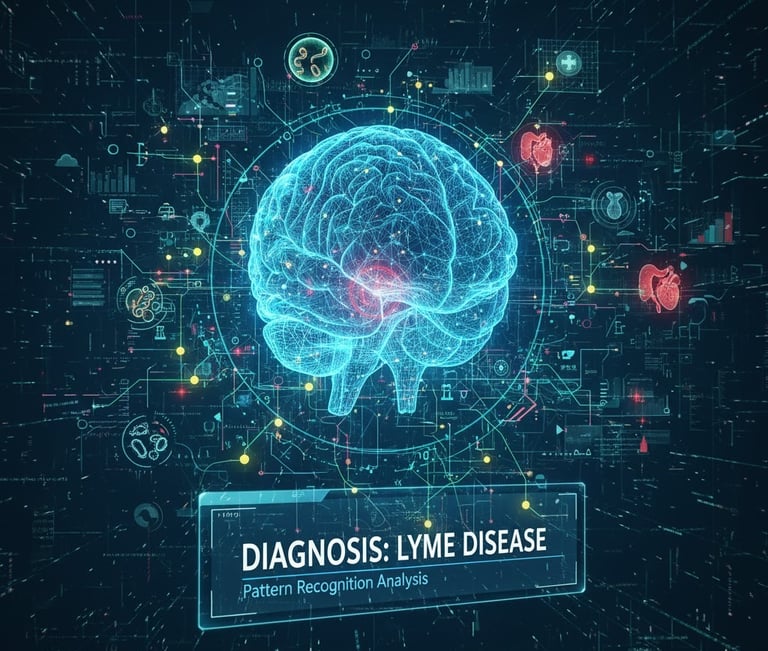"I Survived. I Lived. Then I Woke Up."
AI Diagnoses Lyme Disease Fast — Inspiring Case, Clear Steps & Vital Facts [2025 Guide]
AI diagnoses Lyme disease — a compelling story where AI spotted Lyme after years of “anxiety” labels. Learn symptoms, testing, and what often gets misdiagnosed.
Christopher J
10/14/20256 min read


My post contentThe Headline Story: When “Anxiety” Wasn’t Anxiety
AI diagnoses Lyme disease is more than a catchy phrase; it’s a real scenario that changed one man’s life. After nearly three years of symptoms—tinnitus, fatigue, high blood pressure, and muscle spasms—he kept hearing the same label: anxiety. He turned to an AI tool out of frustration. The AI flagged Lyme disease based on his timeline and symptoms, nudging him back to clinicians for targeted testing and treatment. News outlets summarized the journey and the debate it sparked: can AI help patients and clinicians connect the dots faster without jumping to conclusions? AOL+2Digital Watch Observatory+2
This story isn’t a dunk on doctors. Lyme can be slippery. Symptoms wander across body systems—ears, nerves, joints, skin—and rarely arrive in a neat package. AI’s role here wasn’t to pronounce a diagnosis, but to surface a pattern worth checking with proper medical testing. Used well, AI becomes a flashlight, not a judge. Digital Watch Observatory
Lyme Disease 101: Symptoms, Stages, and Why It’s Tricky
Lyme disease is a bacterial infection caused by Borrelia species carried by blacklegged ticks. Early symptoms can be mild: fever, headache, fatigue, and sometimes a skin lesion called erythema migrans (the “bull’s-eye” rash). Missed early, infection can spread to joints, the heart, and the nervous system. That makes the condition look like many other problems—one reason misfires happen.
Early, Disseminated, and Late Lyme at a Glance
Early localized: days to weeks after a tick bite. Fever, fatigue, headache, and possibly the classic rash.
Early disseminated: weeks to months later. Migrating joint pain, facial palsy, and sometimes heart rhythm issues.
Late disease: months later. Marked arthritis, neuropathic pain, or cognitive fog may appear.
These stages blur. People may not recall a tick bite (nymphs can be poppy-seed tiny), and many never see a rash. That fuels confusion and delays.
The Famous Rash (and Why You Might Not See It)
The erythema migrans rash is helpful when present, but it’s not guaranteed. It can look uniform red, concentric, or oddly shaped—and it can show up in hidden places. Its absence doesn’t rule out Lyme, and its presence doesn’t guarantee it either without context. This is the fog in which AI-supported pattern recognition and careful clinical review can help.
How Doctors Diagnose Lyme: Tests, Timing, and Pitfalls
Here’s the anchor: AI diagnoses Lyme disease only as a hypothesis generator; the formal diagnosis still depends on clinical evaluation and validated lab tests. In the U.S., the CDC recommends two-tier testing. Step one is an enzyme immunoassay (EIA/ELISA). If positive or equivocal, step two is a confirmatory test—traditionally a Western blot, though a modified two-tier approach using two EIAs is increasingly used. A single test rarely tells the whole story; clinicians interpret results alongside exposure history and exam findings. CDC+1
Understanding the Two-Tier Testing Algorithm (EIA + Western Blot/EIA)
Standard Two-Tier Testing (STTT): EIA/ELISA → Western blot.
Modified Two-Tier Testing (MTTT): EIA/ELISA → second EIA/ELISA.
Both are FDA-cleared workflows. The key is clinical context: testing too soon after a bite can miss early infection because antibodies haven’t risen yet. CDC+1
False Negatives, False Positives, and the 30-Day Rule
A classic nuance: IgM bands are most meaningful early on (within ~30 days of symptom onset). Interpreting IgM after that can lead to false positives and confusion. Retesting 1–2 weeks later may show seroconversion (antibody rise) if the infection is new. Precision on timing helps avoid premature reassurance or over-diagnosis. CDC+1
Where AI Helps: Pattern-Spotting, Differential Lists, and Patient Advocacy
AI diagnoses Lyme disease only in the same way a strong differential diagnosis does: by comparing symptom patterns, time courses, and risk factors against known disease signatures. Good AI tools can:
Surface patterns a busy human might miss—like tinnitus + fatigue + tick exposure months earlier.
Organize differentials (the list of possible conditions) and map each to “next best” tests.
Educate patients with plain-language summaries they can bring to appointments. Mount Sinai Health System
What AI Can Do Today vs. What It Can’t
Can: suggest lines of inquiry, highlight red flags, summarize reputable guidelines, and prompt follow-up testing in line with clinical standards.
Can’t: replace CDC-aligned testing, a physical exam, or the clinical judgment that weighs outliers and comorbidities. AI is a map; clinicians are the pilots. When AI “says Lyme,” the next step is evidence-based testing and, if positive, guideline-aligned treatment—not internet folklore or unvalidated labs. CDC+1
3 Conditions Often Mistaken for Lyme (and Vice Versa)
Confusion cuts both ways: other illnesses can masquerade as Lyme, and Lyme can mimic them. Clinicians rely on exposure history, timing, physical findings, and targeted tests to sort things out.
Viral-Like “Summer Flu” and Other Look-Alikes
Fever, chills, headache, and fatigue are shared across many infections. Without a clear rash or known tick bite, early Lyme can look like a run-of-the-mill viral illness. Some tickborne relatives—like Borrelia miyamotoi—overlap clinically with Lyme but require different tests or considerations. Clinical Pain Advisor+1
Autoimmune & Rheumatologic Overlaps (RA, PsA, Spondyloarthritis)
Arthritis after Lyme can resemble rheumatoid arthritis (RA) or spondyloarthritis. Likewise, true RA can be mistaken for “post-Lyme” symptoms. Getting this right matters because treatment paths diverge. Rheumatology sources stress careful differential workups to avoid mislabeling either way. Rheumatology Advisor
Tick-Borne Cousins: B. miyamotoi, Anaplasma, and Friends
Co-infections and other tickborne pathogens can change the symptom picture. Anaplasma or babesiosis, for example, can add fever patterns or blood count changes that help clinicians aim testing. That’s another place where AI-driven checklists can remind everyone to zoom out before zooming in.
A Practical Playbook: Suspect, Document, Test, Follow Up
Here’s a simple, grade-school-clear blueprint that respects the science and keeps your footing steady:
Suspect: If you live in or visited a Lyme-endemic area and have compatible symptoms (especially within weeks to months of outdoor exposure), raise Lyme as a possibility. Make a short symptom timeline including travel, pets (indoor/outdoor), and any remembered tick removal.
Document: Photos of rashes, dates of fever, new neurologic symptoms, and joint swelling help. Include pulse, temperature, and what makes symptoms better/worse.
Test (the right way): Ask for CDC-aligned two-tier testing with FDA-cleared assays. If very early, your clinician may recommend retesting after 1–2 weeks if the first test is negative but suspicion remains. CDC+1
Follow up: Understand the 30-day IgM caveat and ask how your results fit your symptom timing. If tests conflict with the clinical picture, discuss repeats or alternative causes. CDC
Use AI wisely: Let AI help you organize your history and prepare questions. Don’t let it become your lab, your doctor, or your final answer. The star of the show is still a human clinician.
How Patients Can Use AI Responsibly to Speed Correct Care
Prep a one-page summary: symptoms by date, travel/outdoors exposure, pets, and any photos.
Ask AI for a guideline checklist: “What should I discuss for suspected Lyme?” Compare its list to reputable public-health sources—then bring that list to your visit.
Stop at the edge of evidence: Don’t order mail-away tests not aligned with recognized standards. If AI suggests Lyme, the next step is validated testing and clinician review, period. CDC+1
Treatment Basics and What Recovery Can Look Like
Most early Lyme cases respond well to standard antibiotics over several weeks, with improved outcomes the earlier treatment starts. Joint involvement, neurologic symptoms, or cardiac effects may need specialist input and different regimens. The man in the news coverage improved after targeted therapy once Lyme was confirmed—something years of mixed messages hadn’t delivered. This arc, from missed diagnosis to effective care, is the outcome to aim for. AOL
When to Escalate to Specialists (ID, Neuro, Rheum, Cardio)
Infectious disease (ID): complicated or relapsing cases; interpreting tricky serology.
Neurology: facial palsy, neuropathic pain, or cognitive changes.
Rheumatology: persistent arthritis or overlap with autoimmune disease.
Cardiology: suspected Lyme carditis (conduction abnormalities).
The point is collaboration, not turf. Complex presentations deserve a team.
Prevention: Ticks, Time Windows, and Simple Habits That Help
Clothing & repellents: long sleeves, permethrin-treated clothes, and EPA-registered repellents.
Tick checks: shower and scan, especially behind knees, scalp, groin, and waistband areas.
Removal speed: many transmissions require >24 hours of attachment, so early removal can be protective.
Pet pathways: pets can bring ticks indoors; check them after outdoor time.
Final Word: AI + Clinicians + Informed Patients = Fewer Misses
The headline—AI diagnoses Lyme disease—is really a story about better teamwork. AI won’t replace clinical judgment, but it can amplify it by catching patterns, organizing details, and prompting timely, guideline-based testing. The man who found relief after years of “it’s just anxiety” shows what’s at stake: less dismissal, more precision, faster recovery. Pair AI’s flashlight with evidence-based care, and more people get the right answer sooner. AOL+1
References & Notes
Case summaries and quotes about AI pointing to Lyme after years of misdiagnosis. AOL+2Digital Watch Observatory+2
CDC testing guidance on standard and modified two-tier algorithms; testing timing caveats. CDC+3CDC+3CDC+3
Differential diagnosis and common look-alikes noted in rheumatology and clinical advisor sources, including tick-borne cousins and autoimmune overlaps. Rheumatology Advisor+2Rheumatology Advisor+2
Quick Author’s Note on Scope
This article highlights one public case to ground a broader discussion. It’s not a medical diagnosis. For symptoms or testing questions, talk with your clinician and use CDC-aligned resources to guide decisions. Next up, explore how AI is being studied to improve early detection windows for infection—especially before antibodies rise.

Do you have a lifechanging story and want to help others with your experience and inspiration. Please DM me or Send me and
Contact Me
© 2025. All rights reserved.
Privacy Policy
